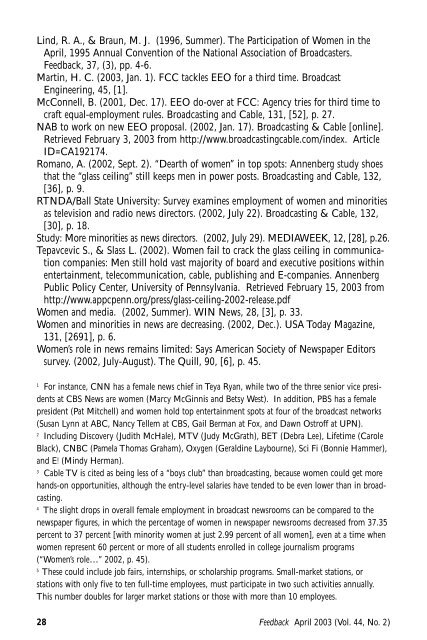APRILFeedback
Feedback April 2003 (Vol. 44, No. 2) - Broadcast Education ...
Feedback April 2003 (Vol. 44, No. 2) - Broadcast Education ...
- No tags were found...
Create successful ePaper yourself
Turn your PDF publications into a flip-book with our unique Google optimized e-Paper software.
Lind, R. A., & Braun, M. J. (1996, Summer). The Participation of Women in theApril, 1995 Annual Convention of the National Association of Broadcasters.Feedback, 37, (3), pp. 4-6.Martin, H. C. (2003, Jan. 1). FCC tackles EEO for a third time. BroadcastEngineering, 45, [1].McConnell, B. (2001, Dec. 17). EEO do-over at FCC: Agency tries for third time tocraft equal-employment rules. Broadcasting and Cable, 131, [52], p. 27.NAB to work on new EEO proposal. (2002, Jan. 17). Broadcasting & Cable [online].Retrieved February 3, 2003 from http://www.broadcastingcable.com/index. ArticleID=CA192174.Romano, A. (2002, Sept. 2). “Dearth of women” in top spots: Annenberg study shoesthat the “glass ceiling” still keeps men in power posts. Broadcasting and Cable, 132,[36], p. 9.RTNDA/Ball State University: Survey examines employment of women and minoritiesas television and radio news directors. (2002, July 22). Broadcasting & Cable, 132,[30], p. 18.Study: More minorities as news directors. (2002, July 29). MEDIAWEEK, 12, [28], p.26.Tepavcevic S., & Slass L. (2002). Women fail to crack the glass ceiling in communicationcompanies: Men still hold vast majority of board and executive positions withinentertainment, telecommunication, cable, publishing and E-companies. AnnenbergPublic Policy Center, University of Pennsylvania. Retrieved February 15, 2003 fromhttp://www.appcpenn.org/press/glass-ceiling-2002-release.pdfWomen and media. (2002, Summer). WIN News, 28, [3], p. 33.Women and minorities in news are decreasing. (2002, Dec.). USA Today Magazine,131, [2691], p. 6.Women’s role in news remains limited: Says American Society of Newspaper Editorssurvey. (2002, July-August). The Quill, 90, [6], p. 45.1For instance, CNN has a female news chief in Teya Ryan, while two of the three senior vice presidentsat CBS News are women (Marcy McGinnis and Betsy West). In addition, PBS has a femalepresident (Pat Mitchell) and women hold top entertainment spots at four of the broadcast networks(Susan Lynn at ABC, Nancy Tellem at CBS, Gail Berman at Fox, and Dawn Ostroff at UPN).2Including Discovery (Judith McHale), MTV (Judy McGrath), BET (Debra Lee), Lifetime (CaroleBlack), CNBC (Pamela Thomas Graham), Oxygen (Geraldine Laybourne), Sci Fi (Bonnie Hammer),and E! (Mindy Herman).3Cable TV is cited as being less of a “boys club” than broadcasting, because women could get morehands-on opportunities, although the entry-level salaries have tended to be even lower than in broadcasting.4The slight drops in overall female employment in broadcast newsrooms can be compared to thenewspaper figures, in which the percentage of women in newspaper newsrooms decreased from 37.35percent to 37 percent [with minority women at just 2.99 percent of all women], even at a time whenwomen represent 60 percent or more of all students enrolled in college journalism programs(“Women’s role…” 2002, p. 45).5These could include job fairs, internships, or scholarship programs. Small-market stations, orstations with only five to ten full-time employees, must participate in two such activities annually.This number doubles for larger market stations or those with more than 10 employees.28Feedback April 2003 (Vol. 44, No. 2)
















